Timeline of eurypterid research
This timeline of eurypterid research is a chronologically ordered list of important fossil discoveries, controversies of interpretation, and taxonomic revisions of eurypterids, a group of extinct aquatic arthropods closely related to modern arachnids and horseshoe crabs that lived during the Paleozoic Era.
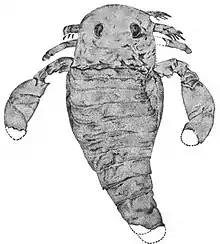
The scientific study of eurypterids began in the early 19th century when James E. DeKay recognized a fossil that had previously been described as that of a fish as arthropod in nature. Though DeKay erroneously believed the fossil to represent a crustacean and a missing link between trilobites and branchiopods, the fossil became the type species of first ever eurypterid to be scientifically described, Eurypterus remipes, in 1825.[1]
Over 250 species of eurypterids in 74 recognized valid genera have been described since the discovery of Eurypterus remipes.[2] The most recent genus to be described is Pruemopterus (2020)[3] and the most recent species to be described is Adelophthalmus pyrrhae (2020).[4]
19th century
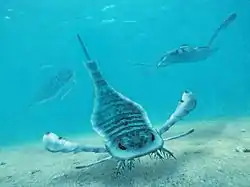
1810s
1818
1820s
- James E. DeKay recognized the fossil described by Mitchill as an arthropod and named it Eurypterus remipes, the first eurypterid to be described scientifically. DeKay interpreted the animal as a crustacean and as the missing link between trilobites and branchiopods.[1]
1830s
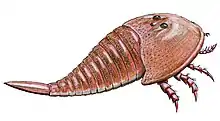
- John Scouler examines and figures fossil remains from Lower Carboniferous Scotland which will later be referred to Hibbertopterus scouleri.[5]
- Scouler described the genus Eidothea based on a single fossil without designating a species name.[6]
- Samuel Hibbert describes the species Eurypterus scouleri, later transferred to its own genus, Hibbertopterus.[5]
- Scouler's Eidothea is discovered to be pre-occupied by a genus of plant, his fossil is found to be similar to Eurypterus scouleri.[6]
- Stepan S. Kutorga described the species Limulus oculatus as an extinct horseshoe crab.[7]
- Louis Agassiz described the new genus Pterygotus, believing the fossils to represent a large fish.[8]
1840s

- Burmeister created the family Eurypteridae to contain Eurypterus.[9]
- Agassiz recognized Pterygotus as an arthropod after the discovery of more complete remains, he classified it as a crustacean of the Entomostraca subclass.[10]
- Agassiz described the species Pterygotus anglicus.[11]
1850s
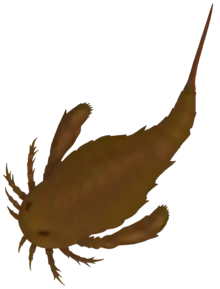
- Hermann Jordan excavates the first fossils of the genus Adelophthalmus.[12]
- John William Salter described the species Pterygotus problematicus.[13]
- Jordan and Hermann von Meyer describe the new species and genus Adelophthalmus granosus.[12]
- August Emanuel von Reuss described the new species and genus Lepidoderma imhofi.[14]
- Salter described the new genus Himantopterus (the genus name was replaced in 1859 by Erettopterus) and the new species H. acuminatus, H. banksii, H. bilobus, H. lanceolatus, H. maximus and H. perornatus.[15]
- Salter described the species Pterygotus acuminata.[16]
- Page transferred Pterygotus acuminata to its own genus, Slimonia.[16]
- Page named and figured, but did not thoroughly describe, the genus Stylonurus.[17]
- Hall describes the species Pterygotus marcophthalmus. It will later be considered part of the genus Acutiramus.[18]
- Hall describes the species Pterygotus osborni.[18]
- Hall describes the species Pterygotus cobbi.[18]
- Salter names a subgenus of Pterygotus, Erettopterus, for species with a bilobed telson.[19]
- Salter described the species Slimonia stylops.[5]
- Salter described the species Eurypterus abbreviatus.[20]
- Salter described the species Pterygotus ludensis.[21]
- Salter described the species Pterygotus punctatus.[22]
- Salter described the species Eurypterus pygmaeus, later recognized as representing fossils of Nanahughmilleria.[5]
- Salter and Thomas Henry Huxley describe the fossil specimens that will later be named Necrogammarus salweyi, believing them to represent some sort of crustacean.[23]
1860s

- Edouard D'Eichwald recognized Kutorga's Limulus oculatus to be highly distinct from Limulus and created the generic name Campylocephalus to contain the species.[24]
- John William Dawson named a new species of plant, Selaginites formosus.[25]
- Henry Woodward described the genus Stylonurus (named and figured, but not thoroughly described, by David Page in 1856) and raised the rank of the Eurypteridae to that of order, effectively creating the Eurypterida as the taxonomic unit it is seen as today.[17]
- Woodward created the subclass Merostomata to contain eurypterids and xiphosurans.[18]
- Ernst Haeckel classified the Merostomata (containing virtually only the Eurypterida) and Xiphosura within a group he named Gigantostraca within the crustaceans. "Gigantostraca" is later treated as a synonym of Mersostomata.[18]
- Salter described the species Pterygotus taurinus.[5]
- Woodward described the species Eurypterus obesus.[18]
- Woodward described the species Eurypterus scorpioides.[26]
- Fielding Bradford Meek and Amos Henry Worthen described the new species and genus Anthraconectes mazonensis. Anthraconectes was designated a subgenus of Eurypterus.[27]
1870s
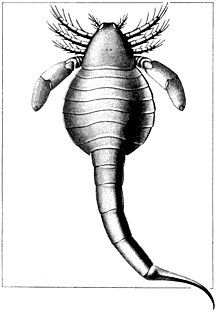
- Henry Woodward described the species Necrogammarus salweyi, believing it to represent an amphipod.[23]
- Dawson reclassified his plant Selaginites formosus as a eurypterid.[19]
- Barrande describes Pterygotus bohemicus, later considered part of the genus Acutiramus, P. kopaninensis and P. nobilis.[28]
- Friedrich Goldenberg coined the name Polyzosternites to replace Adelophthalmus.[29]
- Grote and Pitt describe Pterygotus cummingsi, later considered the type species of Acutiramus.[30]
- Grote and Pitt describe the species Eusarcus scorpionis.[31]
- Dionýs Štúr described the species Eurypterus salmi, later referred to Campylocephalus.[32]
- Meek and Worthen described the species Eurypterus pennsylvanicus, later referred to Adelophthalmus.[33]
- Hall described the species Eurypterus mansfieldi, later referred to Adelophthalmus.[33]
- John William Dawson described the species Erettopterus canadensis.[34]
1880s

- Pohlman described the species Pterygotus buffaloensis. It is later synonymized with P. cummingsi.[35]
- Pohlman described the species Erettopterus grandis.[18]
- The type and only known specimen of Tylopterella boylei (first named Eurypterus boylei) is discovered.[36]
- Ben Peach named the genus Glyptoscorpius to include some fossils from the Carboniferous of Scotland, including the species G. perornatus, G. caledonicus and G. kidstoni. He mistakenly believed the fossils to represent the remains of scorpions.[37]
- Carl Friedrich Schmidt described the species Erettopterus osiliensis.[38]
- The holotype and only known specimen of Vernonopterus minutisculptus is discovered.[39]
- Joseph Frederick Whiteaves described the species Eurypterus boylei.[36]
- Hall described the species Eurypterus prominens.[40]
- Hall and Clarke described the species Eurypterus approximatus, later referred to Adelophthalmus.[2]
- Woodward described the species Eurypterus wilsoni, later referred to Adelophthalmus.[41]
- Matthew described the new genus and species Bunodella horrida as a crustacean.[42]
- Dewalque described the species Eurypterus lohesti.[43]
1890s
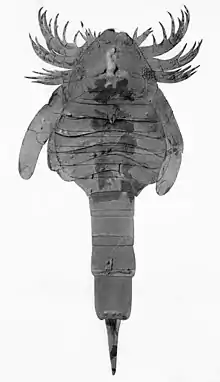
- Edward Waller Claypole described the genus and species Eurysoma newlini. Later that same year he discovered Eurysoma to be pre-occupied, and coined the replacement name Carcinosoma.[44]
- Pereira de Lima described the species Eurypterus douvillei, later referred to Adelophthalmus.[2]
- In the work Anatomy and Relations of the Eurypterida (1893), Malcolm Laurie added considerably to the knowledge and discussion of eurypterid anatomy and relations. He focused on how the eurypterids related to each other and to trilobites, crustaceans, scorpions, other arachnids and horseshoe crabs.[18]
- Gerhard Holm described the species Eurypterus fischeri. His description was so elaborate that the species became one of the most completely known of all extinct animals, so much so that the knowledge of E. fischeri was comparable with the knowledge of its modern relatives (such as the Atlantic horseshoe crab). The description also helped solidify the close relationship between the eurypterids and other chelicerates by showcasing numerous homologies between the two groups.[18]
- Samuel Almond Miller and William Frank Eugene Gurley described the species Eurypterus kokomoensis, later considered the type species of the genus Onychopterella.[31]
20th century
1900s
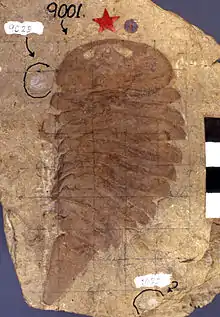
- Charles Emerson Beecher described the new genus and species Strabops thacheri as the only Cambrian eurypterid.[49]
- Sarle described the species Pterygotus monroensis.[50]
- Clifton J. Sarle described the new species Pterygotus monroensis and Eurypterus pittsfordensis. The new genus and species Hughmilleria socialis with the variety H. socialis var. robusta is also described.[51]
- Peach described the new species Glyptoscorpius minutisculptus.[39]
- John Mason Clarke described the new species Pterygotus otisius, Hughmilleria shawangunk, Eurypterus maria, E. myops, E. cicerops and E. cestrotus.[52]
- Woodward described the species Eurypterus moyseyi, later referred to Adelophthalmus.[33]
1910s

- Johan Aschehoug Kiær described the species Eurypterus norvegica.[53]
- Ruedemann and Clarke publish The Eurypterida of New York, wherein several new speciesand taxonomic groupings are created. New species described are Eurypterus megalops, Eurypterus pristinus, Eurypterus ranilarva, Eurypterus stellatus, Eusarcus longiceps, Eusarcus triangulatus, Dolichopterus frankfortensis, Dolichopterus latifrons, Dolichopterus siluriceps, Dolichopterus testudineus, Dolichopterus stylonuroides, Stylonurus limbatus, Ctenopterus multispinosus, Drepanopterus longicaudatus, Hughmilleria magna, Pterygotus atlanticus, Erettopterus globiceps, Pterygotus nasatus and Pterygotus prolificus. They also name the genus Tylopterus (later Tylopterella) and the family Pterygotidae. There are also numerous taxonomic revisions. Eurypterus obesus and E. acrocephalus are referred to the genus Eusarcus.[18] The genus Carcinosoma, to which the species Eurypterus scorpioides and Eurypterus scoticus are transferred, is designated as a junior synonym of Eusarcus.[31] The species Eurypterus kokomoensis is raised to the subgeneric level under the subgenus name Onychopterus.[18]
- Otto Jaekel described the new species Pterygotus rhenaniae, later designated as the type species of Jaekelopterus.[54]
- Erwin H. Barbour described the new species Anthraconectes nebraskensis. The discovery helped reinforce the idea as Adelophthalmus (or Anthraconectes) as a freshwater animal.[55]
- Xavier Stainier described the species Eurypterus dumonti, later referred to Adelophthalmus.[56]
- Thomas Edmund Savage described the species Eurypterus pumilus.[57]
1920s

- Amadeus William Grabau described the species Anthraconectes chinensis.[2]
- Ruedemann described the new species Pterygotus vernonensis.[58]
- Ruedemann described the species Hughmilleria phelpsae, later designated as the type species of Pittsfordipterus.[59]
- Walter A. Bell described the species Anthraconectes brasdorensis.[60]
- Carl Owen Dunbar described the species Anthraconectes sellardsi.[61]
- Embrik Strand described the species Pterygotus siemiradzkii.[62]
1930s
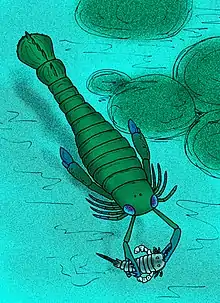
- Boris Isidorovich Chernyshev described the species Eurypterus carbonarius, later referred to Adelophthalmus.[63]
- Eusarcus is recognized as a pre-occupied name by Størmer, who transfers its species to the next oldest available name, Carcinosoma.[31]
- Størmer describes the species Hughmilleria patteni.[64]
- Ruedemann names new subgenera of Pterygotus: Curviramus and Acutiramus. They are differentiated by the curvature of denticles in their chelicerae.[58]
- Størmer provides a more comprehensive and detailed description of Pterygotus rhenaniae.[65]
- Etheridge Jr. described the species Glyptoscorpius stevensoni.[48]
- Carl E. Decker described the species Anthraconectes oklahomensis.[43]
- Gilbert Oscar Raasch referred Strabops to the order Aglaspida.[66]
- Roy Woodhouse Pocock and A. J. Butler discover a relatively complete telson of Eurypterus abbreviatus, showing that the species was highly distinct from other species referred to the genus.[67]
- Pruvost described the species Anthraconectes corneti.[2]
1940s

- Strand proposes the replacement name Eusarcana for Eusarcus but it is ignored since Carcinosoma is already in use as the replacement name.[31]
- Kjellesvig-Waering described the new species Pterygotus ventricosus, later considered the type species of Ciurcopterus.[68]
- Kjellesvig-Waering raised the subgenus Onychopterus to the rank of a separate genus. He also assigned the species Eurypterus pumilus to the genus.[68]
- Boris Isidorovich Chernyshev described the new species Unionopterus anastasiae.[69]
1950s

- Kjellesvig-Waering described the new species Hughmilleria bellistriata.[70]
- Kjellesvig-Waering described the new species Pterygotus floridanus.[50]
- Kjellesvig-Waering described the new family Hughmilleriidae, composed of Hughmilleria, Slimonia, Grossopterus, Lepidoderma, Hastimima and the new genus Salteropterus abbreviatus (formerly a species of Eurypterus), leaving the Pterygotidae monotypic.[67]
- Størmer concluded that Campylocephalus and Hibbertopterus were congeneric. The fossils that had been referred to Ediothea were recognized as representatives of Campylocephalus.[71]
- Størmer noted that the name Onychopterus was pre-occupied and coined the replacement name Onychopterella.[71]
- Kjellesvig-Waering coined the replacement name Tylopterella for the genus Tylopterus, as the name Tylopterus was found to be preoccupied.[72]
- Augusta and Pribyl described the species Ctenopterus ostraviensis.[48]
- Přibyl described the species Anthraconectes zadrai.[43]
- Russell described the new species Pterygotus gaspesiensis.[50]
- Kjellesvig-Waering and Caster describe the species Acutiramus floweri.[58]
- Kjellesvig-Waering describes the species Acutiramus suwanneensis.[73]

- Fredrik Herman van Oyen designate Anthraconectes, Glyptoscorpius, Lepidoderma and Polyzosternites as junior synonyms of Adelophthalmus.[43]
- Pirozhnikov described two new species, Rhenopterus matarakensis and R. schiraensis.[74]
- Kjellesvig-Waering and Størmer describe the new species Pterygotus howelli, which would later be assigned to Jaekelopterus.[75]
- Waterston gives a more complete description of Glyptoscorpius minutisculptus and refers it to Eurypterus as Eurypterus minutisculptus.[39]
- Kjellesvig-Waering reaffirmed the status of Tylopterella as a separate genus from Eurypterus.[76]
- Kjellesvig-Waering publishes a study which determines the coloration of Carcinosoma newlini; showing that it was light brown with darker scales and appendages and a black telson and spines.[44]
- Kjellesvig-Waering recognized Campylocephalus as being distinct from Eurypterus scouleri and erected the genus Hibbertopterus to contain E. scouleri.[2]
- Adelophthalmus oklahomensis is designated a junior synonym of Adelophthalmus sellardsi.[43]
1960s
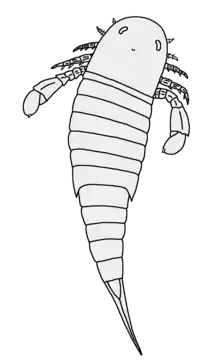
- Kjellesvig-Waering described the new species Salteropterus longilabium, Pterygotus (Pterygotus) denticulatus, P. (P.) grandidentatus, P. (P.) lightbodyi, Carcinosoma harleyi and Dolichopterus bulbosus. The new genus Parahughmilleria is described with P. salteri as the type species. Hughmilleria bellistriata, H. phelpsae and Eurypterus maria are moved to this genus. The subgenus Erettopterus is regarded as a new genus and is separated into two new subgenera, E. (Erettopterus), including the new species E. (E.) brodiei, E. (E.) marstoni and E. (E.) spatulatus, and E. (Truncatiramus), including the new subspecies E. (T.) gigas megalodon. The genus Hughmilleria is split into two new subgenera, H. (Hughmilleria) and H. (Nanahughmilleria).[13]
- Kjellesvig-Waering transfers the species Pterygotus punctatus to Carcinosoma as Pterygotus punctatum.[22]
- Charles D. Waterston names the genus Jaekelopterus to contain the species Pterygotus rhenaniae.[77]
- Kjellesvig-Waering described the species Pterygotus impacatus and Pterygotus lanarkensis.[78]
- Kjellesvig-Waering described the species Pterygotus marylandicus.[50]
- Kjellesvig-Waering questionably assigned Selaginites formosus to Pterygotus as Pterygotus formosus.[79]
- Caster and Khellesvig-Waering recognize Eusarcus and Carcinosoma to represent distinct genera and since Eusarcus is pre-occupied, they coin the replacement name Paracarcinosoma for its species.[31]
- Kjellesvig-Waering and Willard P. Leutze described the new species Bassipterus virginicus (a new genus), Drepanopterus nodosus and Erettopterus (Truncatiramus) exophthalmus. The species H. (N.) phelpsae is classified as a new genus, Pittsfordipterus. Rhenopterus matarakensis is assigned to Parahughmilleria, R. schiraensis is assigned to Hughmilleria (Nanahughmilleria).[70]
- Nestor Ivanovich Novojilov classifies Slimonia into a new family of its own, the Slimonidae.[80]
- Waterston re-examines Eurypterus minutisculptus and concludes that it represents a genus of its own, which he names Vernonopterus.[39]
- Størmer and Waterston re-examine the fossil species referred to Glyptoscorpius and name the new genus Cyrtoctenus, containing the species C. caledonicus, C. dewalquei (previously Eurypterus), C. ostraviensis (previously Ctenopterus) and C. peachi. They also name the genus Dunsopterus to contain the species G. stevensoni.[48]
- Størmer described the species Rhenopterus sievertsi.[81]
1970s
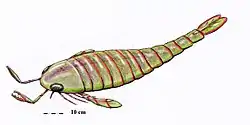
- Kjellesvig-Waering described the species Erettopterus serricaudatus and Erettopterus carinatus.[82]
- Bermudo Meléndez described the species Lepidoderma asturica.[2]
- Kjellesvig-Waering described the species Slimonia boliviana.[83]
1980s
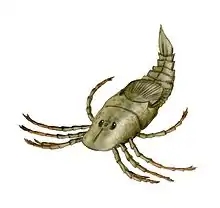
- Mario Hünicken described the new genus and species Megarachne servinei as a mygalomorph spider.[84]
- Barry S. Kues and Kenneth K. Kietzke described the species Adelophthalmus luceroensis.[85]
- Roy E. Plotnick reassigns the species Eurypterus lohesti to Adelophthalmus.[43]
- John E. Almond examined the Necrogammarus fossil, believing it to represent an early aquatic relative of the Uniramia subphylum of arthropods.[23]
- Alexey G. Ponomarenko described the species Hibbertopterus permianus, the last known surviving eurypterid.[86]
- Waterston, Oelofsen and Oosthuizen describe Cyrtoctenus wittebergensis.[87]
- Paul Selden recognizes the fossil remains of Necrogammarus, previously believed to possibly represent a crustacean or a millipede, to be fragmentary fossils of a pterygotid eurypterid.[23]
- Salteropterus is placed in the family Slimonidae by Tollerton.[88]
- Tollerton publishes a major taxonomic revision of the Eurypterida, dividing it into suborders Eurypterina and Ptergotina and recognizing some eurypterids, such as the hibbertopterids, as outside the order and part of a distinct order he calls Cyrtoctenida.[89] Modern research favors suborders Eurypterina and Stylonurina instead.[90]
1990s
- Chlupáč describes the species Acutiramus perneri.[30]
- Braddy, Richard John Aldridge and Johannes N. Theron described the species Onychopterella augusti.[91]
21st century
2000s
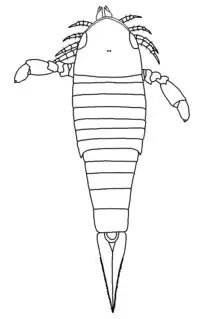
- Poschmann reassigned the species Rhenopterus sievertsi to Adelophthalmus.[81]
- Selden, Corronca and Hünicken recognized Megarachne servinei as a mycteroptid eurypterid.[92]
- Tetlie interpreted Hughmilleria banksii as a new genus, Herefordopterus. In addition, the species Hughmilleria acuminata was synonymized with Herefordopterus banksii.
- Evgenyi S. Shpinev described the species Adelophthalmus irinae.[93]
- Tetlie, Selden & Ren described the new species Hughmilleria wangi.[94]
- Miller and Tetlie determine that Bunodella represents an indeterminate species of Acutiramus. However, it is not formally synonymized and is regarded as a nomen dubium.[95]
- Poschmann and Tetlie determine that Jaekelopterus was a highly derived pterygotid, not a basal form as previously assumed. It is declared to represent the largest known eurypterid.[96]
- Tetlie described the new species Pterygotus sarlei.[97]
- Ciurca and Tetlie transfer the species Pterygotus waylandsmithi to Erettopterus. Additionally, they concluded that P. monroensis was synonymous with E. osiliensis.[58]
- Tetlie and Poschmann reclassify Hughmilleria patteni as part of its own genus, Eysyslopterus.[98]
- Tetlie and Briggs erect the new genus Ciurcopterus to contain species Pterygotus ventricosus and Pterygotus sarlei.[97]
2010s

- Shpinev described the new species Parahughmilleria longa and Nanahughmilleria notosibirica.[99]
- Shpinev described the new species Adelophthalmus kamyshtensis and Adelophthalmus dubius.[100]
- Lamsdell publishes a phylogenetic analysis which finds Merostomata to be invalid, as Xiphosura is paraphyletic, and finds eurypterids to be more closely related to arachnids than to horseshoe crabs.[90]
- Jason A. Dunlop and Lamsdell pointed out that Eusarcana holds priority over Paracarcinosoma as a replacement name for Eusarcus, designating Paracarcinosoma as a junior synonym of Eusarcana.[31]
- Lamsdell reassigned Hibbertopterus permianus to Campylocephalus as Campylocephalus permianus.[86]
- Lamsdell, Simonetto and Selden described the species Adelophthalmus piussii, the first eurypterid to be discovered in Italy.[101]
- Poschmann transferred Erieopterus statzi to the genus Parahughmilleria. The new genus and species Wiedopterus noctua is described.[102]
- Lamsdell et al. described the new genus and species Pentecopterus decorahensis, the oldest eurypterid known to date.[103]
- McCoy, Lamsdell, Poschmann, Anderson and Briggs conduct a study on the eyes of pterygotid eurypterids and determine that the genera included in the family, such as Jaekelopterus, Acutiramus and Ptergyotus, had divergent adaptations, suggesting they had different ecological roles despite their close outward resemblance.[104]
- Vrazo & Ciurca described the new ichnogenus and ichnospecies Arcuites bertiensis, interpreted as traces of a swimming eurypterid.[105]
- Plax et al. described the new genus and species Soligorskopterus tchepeliensis.[106]
- Shpinev & Filimonov described the new species Adelophthalmus khakassicus.[107]
- Emily Hughes concludes that the genera Cyrtoctenus and Dunsopterus represent junior synonyms of Hibbertopterus.[108]
- Schoenemann, Poschmann and Clarkson publish a study comparing the eyes of Jaekelopterus with those of horseshoe crabs, arachnids and other arthropods.[109]
- Naugolnykh and Areshin describe the new species Soligorskopterus shpinevi.[110]
2020s
- Russell D. C. Bicknell, Patrick M. Smith and Poschmann classify the species Pterygotus australis as a nomen dubium.[111]
- Poschmann describes the new genus and species Pruemopterus salgadoi, to date the most recently described eurypterid genus.[3]
- Lamsdell et al. describe Adelophthalmus pyrrhae, to date the most recently described eurypterid species.[4]
References
- Clarke, J. K., Ruedemann R. (1912) "The Eurypterida of New York"
- Dunlop, J. A.; Penney, D.; Jekel, D. (2015). "A summary list of fossil spiders and their relatives (version 16.0)" (PDF). World Spider Catalog.
- Poschmann, Markus J. (2020). "A new sea scorpion (Arthropoda, Eurypterida) from the Early Devonian of Willwerath (Rhineland-Palatinate, SW Germany)". PalZ: 1–10. doi:10.1007/s12542-020-00519-6. S2CID 221478876.
- Lamsdell, James C.; McCoy, Victoria E.; Perron-Feller, Opal A.; Hopkins, Melanie J. (2020). "Air Breathing in an Exceptionally Preserved 340-Million-Year-Old Sea Scorpion". Current Biology. 30 (21): 4316–4321. doi:10.1016/j.cub.2020.08.034. PMID 32916114. S2CID 221590821.
- Kjellesvig-Waering, Erik N. (1961). "The Silurian Eurypterida of the Welsh Borderland". Journal of Paleontology. 35 (4): 789–835. ISSN 0022-3360. JSTOR 1301214.
- Waterston, Charles D. (1958). "XII.—The Scottish Carboniferous Eurypterida*". Earth and Environmental Science Transactions of the Royal Society of Edinburgh. 63 (2): 265–288. doi:10.1017/S0080456800009492. ISSN 2053-5945.
- Kutorga, S. (Stepan) (1838). Beitrag zur Kenntniss der organischen Ueberreste des Kupfersandsteins am westlichen Abhange des Urals. Museum Victoria. Mineralogischen Gesellschaft.
- Murchison, Roderick Impey (1839). The Silurian System, Founded on Geological Researches in the Counties of Salop, Hereford, Radnor, Montgomery, Caermarthen, Brecon, Pembroke, Monmouth, Gloucester, Worcester, and Stafford: With Descriptions of the Coalfields and Overlying Formations. Albemarle Street. p. 606.
pterygotus winged one name.
- Burmeister, Hermann (1843). Die Organisation der Trilobiten aus ihren lebenden Verwandten entwickelt. Georg Reimer.
- M'Coy, Frederick (2009). "XLI.—On the classification of some British fossil Crustacea, with notices of new forms in the University Collection at Cambridge". Annals and Magazine of Natural History. 4 (24): 392–414. doi:10.1080/03745486009494858.
- Miller, Randall F. (2007). "Pterygotus anglicus Agassiz (Chelicerata: Eurypterida) from Atholville, Lower Devonian Campbelltown Formation, New Brunswick, Canada". Palaeontology. 50 (4): 981–999. doi:10.1111/j.1475-4983.2007.00683.x. ISSN 1475-4983.
- Jordan, Hermann; von Meyer, Hermann (1854). "Ueber die Crustaceen der Steinkohlenformation von Saarbrücken". Palaeontographica. 4: 1–15.
- Kjellesvig-Waering, Erik N. (1961). "The Silurian Eurypterida of the Welsh Borderland". Journal of Paleontology. 35 (4): 789–835. JSTOR 1301214.
- Reuss, Adolf E (1855). "Über eine neue Krusterspecies aus der Böhmischen Steinkohlenformation". Denkschriften der Königlich-kaiserlichen Akademie der Wissenschaften in Wien. 10: 81–83.
- Salter, John W. (1856). On some new Crustacea from the uppermost Silurian Rocks. Quarterly Journal of the Geological Society of London. 12. pp. 26–34.
- Nicholson, Henry Alleyne (1868-01-01). "III. On the Occurrence of Fossils in the Old Red Sandstone of Westmoreland". Transactions of the Edinburgh Geological Society. 1 (1): 15–18. doi:10.1144/transed.1.1.15. ISSN 0371-6260. S2CID 131539776.
- Woodward, Henry (1865). "On some New Species of Crustacea belonging to the Order Eurypterida". Quarterly Journal of the Geological Society. 21 (1–2): 484–486. doi:10.1144/GSL.JGS.1865.021.01-02.52.
- Clarke, J. K., Ruedemann R. (1912) "The Eurypterida of New York"
- Kjellesvig-Waering, Erik N. (1964). "A Synopsis of the Family Pterygotidae Clarke and Ruedemann, 1912 (Eurypterida)". Journal of Paleontology. 38 (2): 331–361. JSTOR 1301554.
- Salter, J. W. (1859). "On some New Species of Eurypterus; with Notes on the Distribution of the Species". Quarterly Journal of the Geological Society of London. 15 (1–2): 229–236. doi:10.1144/gsl.jgs.1859.015.01-02.48. S2CID 128767648.
- Lockwood, S (1870). "The Horse Foot Crab". The American Naturalist. 4 (5): 257–274. doi:10.1086/270576. S2CID 83630563.
- Gladwell, David Jeremy (2005). The biota of Upper Silurian submarine channel deposits, Welsh Borderland. Theses, Leicester University Dept. Of Geology (Thesis). University of Leicester.
- "A new identity for the Silurian arthropod Necrogammarus | The Palaeontological Association". www.palass.org. Retrieved 2018-01-14.
- D'Eichwald, Edouard (1860). "2". Lethaea rossica ou Paléontologie de la Russie. 1. p. 1360.
- Dawson, John W. (1871). "Pre-Carboniferous Plants". The Fossil Plants of the Devonian and Upper Silurian Formations of Canada. Geological Survey of Canada. p. 65. doi:10.5962/bhl.title.38239. ISBN 978-0665059063.
- Woodward, Henry (1868). "On some New Species of Crustacea from the Upper Silurian Rocks of Lanarkshire &c.; and further observations on the Structure of Pterygotus". Quarterly Journal of the Geological Society. 24 (1–2): 289–296. doi:10.1144/GSL.JGS.1868.024.01-02.36. ISSN 0370-291X. S2CID 128874377.
- Wills, Leonard J (1964). "The ventral anatomy of the Upper Carboniferous eurypterid Anthraconectes Meek and Worthen". Palaeontology. 7 (3): 474–507.
- Semper, Max (1897). "Die Gigantostraken des Älteren Böhmischen Palaeozoicum" (PDF). Beiträge zur Paläontologie und Geologie Österreich-Ungarns und des Orients.
- Goldenberg, Friedrich (1873). Fauna Saraepontana Fossilis. Die fossilien Thiere aus der Steinkohlenformation von Saarbrücken. Chr. Möllinger Verlag.
- Chlupáč, Ivo (1994). "Pterygotid eurypterids (Arthropoda, Chelicerata) in the Silurian and Devonian of Bohemia" (PDF). Journal of the Czech Geological Society. 39/2-3: 147–162.
- Dunlop, Jason A.; Lamsdell, James C. (2012). "Nomenclatural notes on the eurypterid family Carcinosomatidae". Zoosystematics and Evolution. 88 (1): 19–24. doi:10.1002/zoos.201200003. ISSN 1435-1935.
- Štúr, Dionýs (1877). Die Culmflora der Ostrauer und Waldenburger Schichten. 8. Hölder. pp. 449–450.
- Woodward, Henry (1907). "Two New Species of Eurypterus from the Coal-Measures of Ilkeston, Derbyshire". Geological Magazine. 4 (6): 277–282. doi:10.1017/S0016756800133515.
- Harrington, Bernard J.; Donald, James T.; Billings, Elkanah (1881). "The Canadian Naturalist and Quarterly Journal of Science with the Proceedings of the Natural History Society of Montreal". Quarterly Journal of Science. 9: 103–104.
- Tollerton, V. P. Jr (1997). "The Type Species of the Eurypterid Genus Acutiramus Ruedemann, 1935". Journal of Paleontology. 71 (5): 950–951. doi:10.1017/s0022336000035885.
- Whiteaves, Joseph F. (1884). "On some new, imperfectly characterized or previously unrecorded species of fossils from the Guelph Formations of Ontario". Palaeozoic Fossils of Canada. 3 (1): 1–43.
- Peach, Ben N. (1882). "Further Researches among the Crustacea and Arachnida of the Carboniferous Rocks of the Scottish Border". Earth and Environmental Science Transactions of the Royal Society of Edinburgh. 30 (2): 511–529. doi:10.1017/S0080456800026569. ISSN 2053-5945.
- Schmidt, Friedrich (1883) "Die Crustaceenfauna der Eurypterenschichten von Rootziküll auf Oesel"
- Waterston, Charles D. (1968). "I.—Further Observations on the Scottish Carboniferous Eurypterids*". Earth and Environmental Science Transactions of the Royal Society of Edinburgh. 68 (1): 1–20. doi:10.1017/S0080456800014472. ISSN 2053-5945.
- Erik Tetlie, O.; Poschmann, Markus (2008-06-01). "Phylogeny and palaeoecology of the Adelophthalmoidea (Arthropoda; Chelicerata; Eurypterida)". Journal of Systematic Palaeontology. 6 (2): 237–249. doi:10.1017/S1477201907002416. S2CID 59488956.
- Woodward, Henry (1888). "Note on Eurypterus from the Carboniferous". Geological Magazine. 5 (9): 419. doi:10.1017/S0016756800182494.
- Matthew, G. F. (1889). "On some remarkable organisms of the Silurian and Devonian rocks in southern New Brunswick". Transactions of the Royal Society of Canada. 6 (4): 49–62.
- Tetlie, O. Erik; Dunlop, Jason A. (2005). "A redescription of the Late Carboniferous eurypterids Adelophthalmus granosus von Meyer, 1853 and A. zadrai Přibyl, 1952". Fossil Record. 8 (1): 3–12. doi:10.1002/mmng.200410001. ISSN 1860-1014.
- Kjellesvig-Waering, Erik N. (1958). "Some Previously Unknown Morphological Structures of Carcinosoma newlini (Claypole)". Journal of Paleontology. 32 (2): 295–303. JSTOR 1300736.
- Lamont, Archie (1955-01-01). "Scottish Silurian Chelicerata". Transactions of the Edinburgh Geological Society. 16 (2): 200–216. doi:10.1144/transed.16.2.200. ISSN 0371-6260. S2CID 131492354.
- O'Connell, Marjorie (1916). The Habitat of the Eurypterida. The Bulletin of the Buffalo Society of Natural Sciences. XI (3). Buffalo, N. Y. pp. 1–278.
- McCoy, Frederick (1899). "I.—Note on a New Australian Pterygotus". Geological Magazine. 6 (5): 193–194. Bibcode:1899GeoM....6..193M. doi:10.1017/S0016756800143249. ISSN 1469-5081.
- Waterston, Charles D.; Størmer, Leif (1968). "IV. Cyrtoctenus gen. nov., a large late Palaeozoic Arthropod with pectinate Appendages*". Earth and Environmental Science Transactions of the Royal Society of Edinburgh. 68 (4): 63–104. doi:10.1017/S0080456800014563. ISSN 2053-5945.
- Beecher, C. E. (1901). "Discovery of Eurypterid remains in the Cambrian of Missouri". American Journal of Science. 12 (71): 364–366. Bibcode:1901AmJS...12..364B. doi:10.2475/ajs.s4-12.71.364.
- Lamsdell, James C.; Braddy, Simon J. (2009-10-14). "Cope's Rule and Romer's theory: patterns of diversity and gigantism in eurypterids and Palaeozoic vertebrates". Biology Letters: rsbl20090700. doi:10.1098/rsbl.2009.0700. ISSN 1744-9561. PMID 19828493. Supplementary information
- Sarle, Clifton J. "A new eurypterid fauna from the base of the Salina of western New York". 69. New York State Museum Bulletin: 1080–1108. Cite journal requires
|journal=(help) - Clarke, John M. (1907). The Eurypterus shales of the Shawangunk Mountains in eastern New York. New York State Museum Bulletin. 107. pp. 295–310. Bibcode:1907JG.....15..826C. doi:10.1086/621482.
- Tetlie, O. Erik (2004). Eurypterid phylogeny with remarks on the origin of arachnids (PhD). University of Bristol. pp. 1–344.
- Jaekel, Otto (1914). "Ein grosser Pterygotus aus dem rheinischen Unterdevon". Paläontologische Zeitschrift. 1: 379–382. doi:10.1007/BF03160341. S2CID 129100799.
- Barbour, Erwin H (1914). "Eurypterid Beds of Nebraska with Notice of a New Species, "Eurypterus Nebraskaensis"". Nebraska Geological Survey. 4 (12): 193–203.
- Stainier, Xavier (1915). "On a New Eurypterid from the Belgian Coal Measures". Quarterly Journal of the Geological Society. 71 (1–4): 639–647. doi:10.1144/GSL.JGS.1915.071.01-04.24.
- Savage, Thomas E. (1916). "Alexandrian rocks of northeastern Illinois and eastern Wisconsin". Bulletin of the Geological Society of America. 27 (1): 305–324. Bibcode:1916GSAB...27..305S. doi:10.1130/GSAB-27-305. Archived from the original on 30 December 2018.
- Ciurca, Samuel J.; Tetlie, O. Erik (2007). "Pterygotids (Chelicerata; Eurypterida) from the Silurian Vernon Formation of New York". Journal of Paleontology. 81 (4): 725–736. doi:10.1666/pleo0022-3360(2007)081[0725:PEFTSV]2.0.CO;2. ISSN 0022-3360.
- Ruedemann, Rudolf (1921). "A recurrent Pittsford (Salina) fauna". New York State Museum Bulletin: 205–222.
- Bell, Walter A (1922). "A New Genus of Characeae and New Merostomata from the Coal Measures of Nova Scotia". Transactions of the Royal Society of Canada. 16: 159–167.
- Dunbar, Carl O. (1924). "Kansas Permian insects, Part 1, The geologic occurrence and the environment of the insects". American Journal of Science. 7 (39): 171–209. doi:10.2475/ajs.s5-7.39.171.
- Dunlop, Jason; Erik Tetlie, O (2006). "Embrik Strand's eurypterids". Neues Jahrbuch für Geologie und Paläontologie - Monatshefte. 2006 (11): 696–704. doi:10.1127/njgpm/2006/2006/696.
- Shpinev, Evgeniy S. (2014). "New data on eurypterids (Eurypterida, Chelicerata) of the Upper Carboniferous of the Donets Basin". Paleontological Journal. 48 (3): 287–293. doi:10.1134/S0031030114030162.
- Størmer, Leif (1934). A new eurypterid from the Saaremaa- (Oesel-) beds in Estonia. 37. Publications of the Geological Institution of the University of Tartu. pp. 1–8. OCLC 1006783631.
- Størmer, Leif (1936). "Eurypteriden aus dem Rheinischen Unterdevon". Abhandlungen der Preussischen Geologischen Landesanstalt. N.F., 175.
- Raasch, Gilbert Oscar (1939). Cambrian Merostomata. Geological Society of America. Geological Society of America Special Papers. 19. pp. 1–146. doi:10.1130/SPE19. ISBN 9780813720197.
- Kjellesvig-Waering, Erik N. (1951). "Downtonian (Silurian) Eurypterida from Perton, near Stoke Edith, Herefordshire". Geological Magazine. 88 (1): 1–24. Bibcode:1951GeoM...88....1K. doi:10.1017/S0016756800068874. ISSN 1469-5081.
- Kjellesvig-Waering, Erik N. (1948). "Two New Eurypterids from the Silurian of Indiana". Journal of Paleontology. 22 (4): 465–472. JSTOR 1299516.
- Chernyshev, Boris I. (1948). "New representative of Merostomata from the Lower Carboniferous". State University of Kiev, Geological Collections. 2: 119–130.
- Kjellesvig-Waering, Erik N. (1950). "A New Silurian Hughmilleria from West Virginia". Journal of Paleontology. 24 (2): 226–228. JSTOR 1299503.
- Størmer, Leif (1951). "A New Eurypterid from the Ordovician of Montgomeryshire, Wales". Geological Magazine. 88 (6): 409–422. Bibcode:1951GeoM...88..409S. doi:10.1017/S001675680006996X. ISSN 1469-5081.
- Størmer, Leif (1951). "A New Eurypterid from the Ordovician of Montgomeryshire, Wales". Geological Magazine. 88 (6): 409–422. Bibcode:1951GeoM...88..409S. doi:10.1017/S001675680006996X.
- Kjellesvig-Waering, Erik N. (1955). "A New Phyllocarid and Eurypterid from the Silurian of Florida". Journal of Paleontology. 29 (2): 295–297. JSTOR 1300471.
- Pirozhnikov, L. P. (1957). "Remains of Gigantostraca from the series of Matakara (Devonian of the North Minusinsk Depression)". Vsesojuzuoe Paleontologiceskoe Obchestvo Ezegodnik. 16: 207–213. ISSN 0201-9280. OCLC 229469975.
- Poschmann, Markus; Tetlie, O. Erik (2006-12-01). "On the Emsian (Lower Devonian) arthropods of the Rhenish Slate Mountains: 5. Rare and poorly known eurypterids from Willwerath, Germany". Paläontologische Zeitschrift. 80 (4): 325–343. doi:10.1007/BF02990208. S2CID 129716740.
- Kjellesvig-Waering, Erik N. (1958). "The Genera, Species and Subspecies of the Family Eurypteridae, Burmeister, 1845". Journal of Paleontology. 32 (6): 1107–1148. JSTOR 1300776.
- D. Waterston, Charles (1964-01-01). "II.—Observations on Pterygotid Eurypterids". Transactions of the Royal Society of Edinburgh. 66 (2): 9–33. doi:10.1017/S0080456800023309.
- Kjellesvig-Waering, Erik N. (1964). "A Synopsis of the Family Pterygotidae Clarke and Ruedemann, 1912 (Eurypterida)". Journal of Paleontology. 38 (2): 331–361. JSTOR 1301554.
- Kjellesvig-Waering, Erik N. (1964). "A Synopsis of the Family Pterygotidae Clarke and Ruedemann, 1912 (Eurypterida)". Journal of Paleontology. 38 (2): 331–361. JSTOR 1301554.
- Dunlop, J. A., Penney, D. & Jekel, D. 2015. A summary list of fossil spiders and their relatives. In World Spider Catalog. Natural History Museum Bern, online at http://wsc.nmbe.ch, version 16.0 http://www.wsc.nmbe.ch/resources/fossils/Fossils16.0.pdf (PDF).
- Poschmann, Markus (2006). "The Eurypterid Adelophthalmus Sievertsi (chelicerata: Eurypterida) from the Lower Devonian (emsian) Klerf Formation of Willwerath, Germany". Palaeontology. 49 (1): 67–82. doi:10.1111/j.1475-4983.2005.00528.x.
- Sven Laufeld; Roland Skoglund (1979). Lower Wenlock faunal and floral dynamics – Vattenfallet section, Gotland (PDF). Sveriges Geologiska Undersökning. ISBN 978-9171581709.
- Kjellesvig-Waering, Erik N. (1973). "A new Silurian Slimonia (Eurypterida) from Bolivia". Journal of Paleontology. 47 (3): 549–550. JSTOR 1303202.
- Hünicken, Mario A. (1980). "A giant fossil spider (Megarachne servinei) from Bajo de Véliz, Upper Carboniferous, Argentina". Boletin de la Academia Nacional de Ciencias, Córdoba, Argentina. 53: 317–341.
- Kues, Barry S.; Kietzke, Kenneth K. (1981). "A Large Assemblage of a New Eurypterid from the Red Tanks Member, Madera Formation (Late Pennsylvanian-Early Permian) of New Mexico". Journal of Paleontology. 55 (4): 709–729. JSTOR 1304420.
- Lamsdell, James (2012). "Redescription of Drepanopterus pentlandicus Laurie, 1892, the earliest known mycteropoid (Chelicerata: Eurypterida) from the early Silurian (Llandovery) of the Pentland Hills, Scotland". Earth and Environmental Science Transactions of the Royal Society of Edinburgh. 103: 77–103. doi:10.1017/S1755691012000072.
- D. Waterston, C; W. Oelofsen, B; D. F. Oosthuizen, R (1985-01-01). "Cyrtoctenus wittebergensis sp. nov. (Chelicerata: Eurypterida), a large sweep-feeder from the Carboniferous of South Africa". Transactions of the Royal Society of Edinburgh: Earth Sciences. 76 (2–3): 339–358. doi:10.1017/S0263593300010555.
- Tollerton, V. P. (1989). "Morphology, taxonomy, and classification of the order Eurypterida Burmeister, 1843". Journal of Paleontology. 63 (5): 642–657. doi:10.1017/S0022336000041275. ISSN 0022-3360.
- Tollerton, Victor P. (1989). "Morphology, Taxonomy, and Classification of the Order Eurypterida Burmeister, 1843". Journal of Paleontology. 63 (5): 642–657. doi:10.1017/S0022336000041275. JSTOR 1305624.
- Lamsdell, James C. (2012). "Revised systematics of Palaeozoic 'horseshoe crabs' and the myth of monophyletic Xiphosura". Zoological Journal of the Linnean Society. 167: 1–27. doi:10.1111/j.1096-3642.2012.00874.x.
- Braddy, Simon J.; Aldridge, Richard J.; Theron, Johannes N. (1995). "A new eurypterid from the Late Ordovician Table Mountain Group, South Africa". Palaeontology. 38: 563–581.
- Selden, Paul A; Corronca, José A; Hünicken, Mario A (2005-03-22). "The true identity of the supposed giant fossil spider Megarachne". Biology Letters. 1 (1): 44–48. doi:10.1098/rsbl.2004.0272. ISSN 1744-9561. PMC 1629066. PMID 17148124.
- Shpinev, Evgeniy S. (2006). "A new species of Adelophthalmus (Eurypterida) from the lower carboniferous of the Krasnoyarsk Region". Paleontological Journal. 40 (4): 431–433. doi:10.1134/S0031030106040083.
- Erik Tetlie, Paul A Selden, Dong Ren (2007). "A new Silurian eurypterid (Arthropoda: Chelicerata) from China". Palaeontology. 50 (3): 619–625. doi:10.1111/j.1475-4983.2007.00651.x. hdl:1808/8354.CS1 maint: uses authors parameter (link)
- Miller, Randall F.; Tetlie, O. Erik (2007). "The presumed Synziphosuran Bunodella horrida Matthew, 1889 (Silurian; Cunningham Creek Formation, New Brunswick, Canada) is a eurypterid". Journal of Paleontology. 81 (3): 588–590. doi:10.1666/05127.1. S2CID 85708511.
- Braddy, Simon J.; Poschmann, Markus; Tetlie, O. Erik (2007). "Giant claw reveals the largest ever arthropod". Biology Letters. 4 (1): 106–109. doi:10.1098/rsbl.2007.0491. PMC 2412931. PMID 18029297.
- Tetlie, O. Erik; Briggs, Derek E. G. (2009-09-01). "The origin of pterygotid eurypterids (Chelicerata: Eurypterida)". Palaeontology. 52 (5): 1141–1148. doi:10.1111/j.1475-4983.2009.00907.x. ISSN 1475-4983.
- Erik Tetlie, O; Poschmann, Markus (2008-06-01). "Phylogeny and palaeoecology of the Adelophthalmoidea (Arthropoda; Chelicerata; Eurypterida)". Journal of Systematic Palaeontology. 6 (2): 237–249. doi:10.1017/S1477201907002416. S2CID 59488956.
- Shpinev, E. S. (2012). "On some eurypterids (Eurypterida, Chelicerata) from the Devonian of South Siberia". Paleontological Journal. 46 (4): 370–377. doi:10.1134/S0031030112040119. S2CID 128903698.
- Shpinev, Evgeniy S. (2012). "New species of the genus Adelophthalmus (Eurypterida, Chelicerata) found in the Middle Devonian of Khakassia". Paleontological Journal. 46 (5): 470–475. doi:10.1134/S0031030112050103.
- Lamsdell, James C.; Simonetto, Luca; Selden, Paul A. (2013). "First Eurypterid from Italy: A new species of Adelophthalmus (Chelicerata: Eurypterida) from the Upper Carboniferous of the Carnic Alps (Friuli, NE Italy)". Rivista Italiana di Paleontologia e Stratigrafia (Research in Paleontology and Stratigraphy). 119 (2): 147–151. doi:10.13130/2039-4942/6029.
- Poschmann, Markus (2015-12-01). "Sea scorpions (Chelicerata, Eurypterida) from the Lower Devonian (Siegenian) of the Lahrbach Valley/Westerwald area (SW Germany, Rhineland-Palatinate)". Paläontologische Zeitschrift. 89 (4): 783–793. doi:10.1007/s12542-015-0261-9. ISSN 0031-0220. S2CID 128555537.
- Lamsdell, James C.; Briggs, Derek E. G.; Liu, Huaibao; Witzke, Brian J.; McKay, Robert M. (2015). "The oldest described eurypterid: a giant Middle Ordovician (Darriwilian) megalograptid from the Winneshiek Lagerstätte of Iowa". BMC Evolutionary Biology. 15: 169. doi:10.1186/s12862-015-0443-9. PMC 4556007. PMID 26324341.
- McCoy, Victoria E.; Lamsdell, James C.; Poschmann, Markus; Anderson, Ross P.; Briggs, Derek E. G. (2015-08-01). "All the better to see you with: eyes and claws reveal the evolution of divergent ecological roles in giant pterygotid eurypterids". Biology Letters. 11 (8): 20150564. doi:10.1098/rsbl.2015.0564. PMC 4571687. PMID 26289442.
- Vrazo, Matthew B.; Ciurca, Samuel J. (2017). "New trace fossil evidence for eurypterid swimming behaviour". Palaeontology. 61 (7): 235–252. doi:10.1111/pala.12336. ISSN 1475-4983.
- Plax, Dmitry P.; Lamsdell, James C.; Vrazo, Matthew B.; Barbikov, Dmitry V. (2018). "A new genus of eurypterid (Chelicerata, Eurypterida) from the Upper Devonian salt deposits of Belarus". Journal of Paleontology. 92 (5): 838–849. doi:10.1017/jpa.2018.11. S2CID 134054742.
- Shpinev, Evgeniy S.; Filimonov, A. N. (2018). "A New Record of Adelophthalmus (Eurypterida, Chelicerata) from the Devonian of the South Minusinsk Depression". Paleontological Journal. 52 (13): 1553–1560. doi:10.1134/S0031030118130129. S2CID 91741388.
- Hughes, Emily Samantha (2019), "Discerning the Diets of Sweep-Feeding Eurypterids Through Analyses of Mesh-Modified Appendage Armature". Graduate Theses, Dissertations, and Problem Reports. 3890.
- Schoenemann, Brigitte; Poschmann, Markus; Clarkson, Euan N. K. (2019-11-28). "Insights into the 400 million-year-old eyes of giant sea scorpions (Eurypterida) suggest the structure of Palaeozoic compound eyes". Scientific Reports. 9 (1): 17797. Bibcode:2019NatSR...917797S. doi:10.1038/s41598-019-53590-8. ISSN 2045-2322. PMC 6882788. PMID 31780700.
- Naugolnykh, Serge V.; Areshin, Alexander V. (2019). "A new representative of a stylonuroid eurypterid from the Upper Devonian of the Kursk region, Russia". PalZ. 94 (3): 439–447. doi:10.1007/s12542-019-00501-x. S2CID 209312005.
- Bicknell, Russell D. C.; Smith, Patrick M.; Poschmann, Markus (2020). "Re-evaluating evidence of Australian eurypterids". Gondwana Research. 86: 164–181. Bibcode:2020GondR..86..164B. doi:10.1016/j.gr.2020.06.002.
External links
 Media related to Eurypterida at Wikimedia Commons
Media related to Eurypterida at Wikimedia Commons